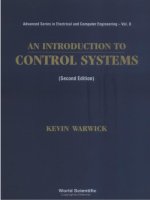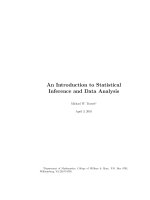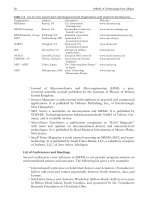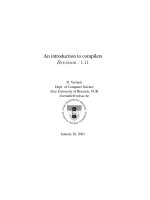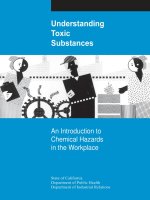an introduction to chemical kinetics
Bạn đang xem bản rút gọn của tài liệu. Xem và tải ngay bản đầy đủ của tài liệu tại đây (2.34 MB, 455 trang )
An Introduction to
Chemical Kinetics
An Introduction to Chemical Kinetics. Margaret Robson Wright
# 2004 John Wiley & Sons, Ltd. ISBNs: 0-470-09058-8 (hbk) 0-470-09059-6 (pbk)
An Introduction to
Chemical Kinetics
Margaret Robson Wright
Formerly of The University of St Andrews, UK
Copyright # 2004 John Wiley & Sons Ltd, The Atrium, Southern Gate, Chichester,
West Sussex PO19 8SQ, England
Telephone (+44) 1243 779777
Email (for orders and customer service enquiries):
Visit our Home Page on www.wileyeurope.com or www.wiley.com
All Rights Reserved. No part of this publication may be reproduced, stored in a retrieval system or transmitted
in any form or by any means, electronic, mechanical, photocopying, recording, scanning or otherwise, except
under the terms of the Copyright, Designs and Patents Act 1988 or under the terms of a licence issued by the
Copyright Licensing Agency Ltd, 90 Tottenham Court Road, London W1T 4LP, UK, without the permission
in writing of the Publisher. Requests to the Publisher should be addressed to the Permissions Department,
John Wiley & Sons Ltd, The Atrium, Southern Gate, Chichester, West Sussex PO19 8SQ, England, or
emailed to , or faxed to (+44) 1243 770620.
This publication is designed to provide accurate and authoritative information in regard to the subject matter
covered. It is sold on the understanding that the Publisher is not engaged in rendering professional services. If
professional advice or other expert assistance is required, the services of a competent professional should be
sought.
Other Wiley Editorial Offices
John Wiley & Sons Inc., 111 River Street, Hoboken, NJ 07030, USA
Jossey-Bass, 989 Market Street, San Francisco, CA 94103-1741, USA
Wiley–VCH Verlag GmbH, Boschstrasse 12, D-69469 Weinheim, Germany
John Wiley & Sons Australia Ltd, 33 Park Road, Milton, Queensland 4064, Australia
John Wiley & Sons (Asia) Pte Ltd, 2 Clementi Loop # 02-01, Jin Xing Distripark, Singapore 129809
John Wiley & Sons Canada Ltd, 22 Worcester Road, Etobicoke, Ontario, Canada M9W 1L1
Wiley also publishes its books in a variety of electronic formats. Some content that appears in
print may not be available in electronic books.
Library of Congress Cataloging-in-Publication Data
Wright, Margaret Robson.
An introduction to chemical kinetics / Margaret Robson Wright.
p. cm.
Includes bibliographical references and index.
ISBN 0-470-09058-8 (acid-free paper) – ISBN 0-470-09059-6 (pbk. : acid-free paper)
1. Chemical kinetics. I. Title.
QD502.W75 2004
541
0
.394–dc22 2004006062
British Library Cataloguing in Publication Data
A catalogue record for this book is available from the British Library
ISBN 0 470 09058 8 hardback
0 470 09059 6 paperback
Typeset in 10.5/13pt Times by Thomson Press (India) Limited, New Delhi
Printed and bound in Great Britain by TJ International Ltd., Padstow, Cornwall
This book is printed on acid-free paper responsibly manufactured from sustainable forestry
in which at least two trees are planted for each one used for paper production.
Dedicated with much love and affection
to
my mother, Anne (in memoriam),
with deep gratitude for all her loving help,
to
her oldest and dearest friends,
Nessie (in memoriam) and Dodo Gilchrist of Cumnock, who,
by their love and faith in me, have always been a source of great
encouragement to me,
and last, but not least, to my own immediate family,
my husband, Patrick,
our children Anne, Edward and Andrew and our cats.
Contents
Preface xiii
List of Symbols xvii
1 Introduction 1
2 Experimental Procedures 5
2.1 Detection, Identification and Estimation of Concentration of Species Present 6
2.1.1 Chromatographic techniques: liquid–liquid and gas–liquid chromatography 6
2.1.2 Mass spectrometry (MS) 6
2.1.3 Spectroscopic techniques 7
2.1.4 Lasers 13
2.1.5 Fluorescence 14
2.1.6 Spin resonance methods: nuclear magnetic resonance (NMR) 15
2.1.7 Spin resonance methods: electron spin resonance (ESR) 15
2.1.8 Photoelectron spectroscopy and X-ray photoelectron spectroscopy 15
2.2 Measuring the Rate of a Reaction 17
2.2.1 Classification of reaction rates 17
2.2.2 Factors affecting the rate of reaction 18
2.2.3 Common experimental features for all reactions 19
2.2.4 Methods of initiation 19
2.3 Conventional Methods of Following a Reaction 20
2.3.1 Chemical methods 20
2.3.2 Physical methods 21
2.4 Fast Reactions 27
2.4.1 Continuous flow 27
2.4.2 Stopped flow 28
2.4.3 Accelerated flow 29
2.4.4 Some features of flow methods 29
2.5 Relaxation Methods 30
2.5.1 Large perturbations 31
2.5.2 Flash photolysis 31
2.5.3 Laser photolysis 32
2.5.4 Pulsed radiolysis 32
2.5.5 Shock tubes 33
2.5.6 Small perturbations: temperature, pressure and electric field jumps 33
2.6 Periodic Relaxation Techniques: Ultrasonics 35
2.7 Line Broadening in NMR and ESR Spectra 38
Further Reading 38
Further Problems 39
3 The Kinetic Analysis of Experimental Data 43
3.1 The Experimental Data 44
3.2 Dependence of Rate on Concentration 47
3.3 Meaning of the Rate Expression 48
3.4 Units of the Rate Constant, k 49
3.5 The Significance of the Rate Constant as Opposed to the Rate 50
3.6 Determining the Order and Rate Constant from Experimental Data 52
3.7 Systematic Ways of Finding the Order and Rate Constant from Rate/
Concentration Data 53
3.7.1 A straightforward graphical method 55
3.7.2 log/log graphical procedures 55
3.7.3 A systematic numerical procedure 56
3.8 Drawbacks of the Rate/Concentration Methods of Analysis 58
3.9 Integrated Rate Expressions 58
3.9.1 Half-lives 59
3.10 First Order Reactions 62
3.10.1 The half-life for a first order reaction 63
3.10.2 An extra point about first order reactions 64
3.11 Second Order Reactions 66
3.11.1 The half-life for a second order reaction 67
3.11.2 An extra point about second order reactions 68
3.12 Zero Order Reaction 68
3.12.1 The half-life for a zero order reaction 70
3.13 Integrated Rate Expressions for Other Orders 71
3.14 Main Features of Integrated Rate Equations 71
3.15 Pseudo-order Reactions 74
3.15.1 Application of pseudo-order techniques to rate/concentration data 75
3.16 Determination of the Product Concentration at Various Times 77
3.17 Expressing the Rate in Terms of Reactants or Products for Non-simple
Stoichiometry 79
3.18 The Kinetic Analysis for Complex Reactions 79
3.18.1 Relatively simple reactions which are mathematically complex 81
3.18.2 Analysis of the simple scheme A À!
k
1
I À!
k
2
P81
3.18.3 Two conceivable situations 82
3.19 The Steady State Assumption 84
3.19.1 Using this assumption 84
3.20 General Treatment for Solving Steady States 86
3.21 Reversible Reactions 89
3.21.1 Extension to other equilibria 90
3.22 Pre-equilibria 92
3.23 Dependence of Rate on Temperature 92
Further Reading 95
Further Problems 95
4 Theories of Chemical Reactions 99
4.1 Collision Theory 100
4.1.1 Definition of a collision in simple collision theory 100
4.1.2 Formulation of the total collision rate 102
4.1.3 The p factor 108
4.1.4 Reaction between like molecules 110
4.2 Modified Collision Theory 110
viii CONTENTS
4.2.1 A new definition of a collision 110
4.2.2 Reactive collisions 111
4.2.3 Contour diagrams for scattering of products of a reaction 112
4.2.4 Forward scattering: the stripping or grazing mechanism 117
4.2.5 Backward scattering: the rebound mechanism 118
4.2.6 Scattering diagrams for long-lived complexes 119
4.3 Transition State Theory 122
4.3.1 Transition state theory, configuration and potential energy 122
4.3.2 Properties of the potential energy surface relevant to transition
state theory 123
4.3.3 An outline of arguments involved in the derivation of the rate equation 131
4.3.4 Use of the statistical mechanical form of transition state theory 135
4.3.5 Comparisons with collision theory and experimental data 136
4.4 Thermodynamic Formulations of Transition State Theory 140
4.4.1 Determination of thermodynamic functions for activation 142
4.4.2 Comparison of collision theory, the partition function form and the
thermodynamic form of transition state theory 142
4.4.3 Typical approximate values of contributions entering the sign
and magnitude of ÁS
6¼Ã
144
4.5 Unimolecular Theory 145
4.5.1 Manipulation of experimental results 148
4.5.2 Physical significance of the constancy or otherwise of k
1
, k
À1
and k
2
151
4.5.3 Physical significance of the critical energy in unimolecular reactions 152
4.5.4 Physical significance of the rate constants k
1
, k
À1
and k
2
153
4.5.5 The simple model: that of Lindemann 153
4.5.6 Quantifying the simple model 154
4.5.7 A more complex model: that of Hinshelwood 155
4.5.8 Quantifying Hinshelwood’s theory 155
4.5.9 Critique of Hinshelwood’s theory 157
4.5.10 An even more complex model: that of Kassel 158
4.5.11 Critique of the Kassel theory 159
4.5.12 Energy transfer in the activation step 159
4.6 The Slater Theory 160
Further Reading 162
Further Problems 162
5 Potential Energy Surfaces 165
5.1 The Symmetrical Potential Energy Barrier 165
5.2 The Early Barrier 167
5.3 The Late Barrier 167
5.4 Types of Elementary Reaction Studied 168
5.5 General Features of Early Potential Energy Barriers for Exothermic Reactions 170
5.6 General Features of Late Potential Energy Surfaces for Exothermic Reactions 172
5.6.1 General features of late potential energy surfaces where the
attacking atom is light 173
5.6.2 General features of late potential energy surfaces for exothermic
reactions where the attacking atom is heavy 175
5.7 Endothermic Reactions 177
5.8 Reactions with a Collision Complex and a Potential Energy Well 178
Further Reading 180
Further Problems 180
CONTENTS ix
6 Complex Reactions in the Gas Phase 183
6.1 Elementary and Complex Reactions 184
6.2 Intermediates in Complex Reactions 186
6.3 Experimental Data 188
6.4 Mechanistic Analysis of Complex Non-chain Reactions 189
6.5 Kinetic Analysis of a Postulated Mechanism: Use of the Steady State Treatment 192
6.5.1 A further example where disentangling of the kinetic data is necessary 195
6.6 Kinetically Equivalent Mechanisms 198
6.7 A Comparison of Steady State Procedures and Equilibrium Conditions in
the Reversible Reaction 202
6.8 The Use of Photochemistry in Disentangling Complex Mechanisms 204
6.8.1 Kinetic features of photochemistry 204
6.8.2 The reaction of H
2
with I
2
206
6.9 Chain Reactions 208
6.9.1 Characteristic experimental features of chain reactions 209
6.9.2 Identification of a chain reaction 210
6.9.3 Deduction of a mechanism from experimental data 211
6.9.4 The final stage: the steady state analysis 213
6.10 Inorganic Chain Mechanisms 213
6.10.1 The H
2
/Br
2
reaction 213
6.10.2 The steady state treatment for the H
2
/Br
2
reaction 214
6.10.3 Reaction without inhibition 216
6.10.4 Determination of the individual rate constants 217
6.11 Steady State Treatments and Possibility of Determination of All the Rate
Constants 218
6.11.1 Important points to note 221
6.12 Stylized Mechanisms: A Typical Rice–Herzfeld Mechanism 221
6.12.1 Dominant termination steps 223
6.12.2 Relative rate constants for termination steps 224
6.12.3 Relative rates of the termination steps 224
6.12.4 Necessity for third bodies in termination 227
6.12.5 The steady state treatment for chain reactions, illustrating the use
of the long chains approximation 229
6.12.6 Further problems on steady states and the Rice–Herzfeld mechanism 233
6.13 Special Features of the Termination Reactions: Termination at the Surface 240
6.13.1 A general mechanism based on the Rice–Herzfeld mechanism
used previously 240
6.14 Explosions 243
6.14.1 Autocatalysis and autocatalytic explosions 244
6.14.2 Thermal explosions 244
6.14.3 Branched chain explosions 244
6.14.4 A highly schematic and simplified mechanism for a
branched chain reaction 246
6.14.5 Kinetic criteria for non-explosive and explosive reaction 247
6.14.6 A typical branched chain reaction showing explosion limits 249
6.14.7 The dependence of rate on pressure and temperature 250
6.15 Degenerate Branching or Cool Flames 252
6.15.1 A schematic mechanism for hydrocarbon combustion 254
6.15.2 Chemical interpretation of ‘cool’flame behaviour 257
Further Reading 259
Further Problems 260
x CONTENTS
7 Reactions in Solution 263
7.1 The Solvent and its Effect on Reactions in Solution 263
7.2 Collision Theory for Reactions in Solution 265
7.2.1 The concepts of ideality and non-ideality 268
7.3 Transition State Theory for Reactions in Solution 269
7.3.1 Effect of non-ideality: the primary salt effect 269
7.3.2 Dependence of ÁS
6¼Ã
and ÁH
6¼Ã
on ionic strength 279
7.3.3 The effect of the solvent 280
7.3.4 Extension to include the effect of non-ideality 284
7.3.5 Deviations from predicted behaviour 284
7.4 ÁS
6¼Ã
and Pre-exponential A Factors 289
7.4.1 A typical problem in graphical analysis 292
7.4.2 Effect of the molecularity of the step for which ÁS
6¼Ã
is found 292
7.4.3 Effect of complexity of structure 292
7.4.4 Effect of charges on reactions in solution 293
7.4.5 Effect of charge and solvent on ÁS
6¼Ã
for ion–ion reactions 293
7.4.6 Effect of charge and solvent on ÁS
6¼Ã
for ion–molecule reactions 295
7.4.7 Effect of charge and solvent on ÁS
6¼Ã
for molecule–molecule reactions 296
7.4.8 Effects of changes in solvent on ÁS
6¼Ã
296
7.4.9 Changes in solvation pattern on activation, and the effect on A factors
for reactions involving charges and charge-separated species in solution 296
7.4.10 Reactions between ions in solution 297
7.4.11 Reaction between an ion and a molecule 298
7.4.12 Reactions between uncharged polar molecules 299
7.5 ÁH
6¼Ã
Values 301
7.5.1 Effect of the molecularity of the step for which the ÁH
6¼Ã
value
is found 301
7.5.2 Effect of complexity of structure 302
7.5.3 Effect of charge and solvent on ÁH
6¼Ã
for ion–ion and
ion–molecule reactions 302
7.5.4 Effect of the solvent on ÁH
6¼Ã
for ion–ion and ion–molecule reactions 303
7.5.5 Changes in solvation pattern on activation and the effect on ÁH
6¼Ã
303
7.6 Change in Volume on Activation, ÁV
6¼Ã
304
7.6.1 Effect of the molecularity of the step for which ÁV
6¼Ã
is found 305
7.6.2 Effect of complexity of structure 306
7.6.3 Effect of charge on ÁV
6¼Ã
for reactions between ions 306
7.6.4 Reactions between an ion and an uncharged molecule 308
7.6.5 Effect of solvent on ÁV
6¼Ã
308
7.6.6 Effect of change of solvation pattern on activation and its
effect on ÁV
6¼Ã
308
7.7 Terms Contributing to Activation Parameters 310
7.7.1 ÁS
6¼Ã
310
7.7.2 ÁV
6¼Ã
310
7.7.3 ÁH
6¼Ã
311
Further Reading 314
Further Problems 314
8 Examples of Reactions in Solution 317
8.1 Reactions Where More than One Reaction Contributes to the Rate of
Removal of Reactant 317
8.1.1 A simple case 318
CONTENTS xi
8.1.2 A slightly more complex reaction where reaction occurs by two concurrent
routes, and where both reactants are in equilibrium with each other 321
8.1.3 Further disentangling of equilibria and rates, and the possibility of
kinetically equivalent mechanisms 328
8.1.4 Distinction between acid and base hydrolyses of esters 331
8.2 More Complex Kinetic Situations Involving Reactants in Equilibrium with Each
Other and Undergoing Reaction 336
8.2.1 A further look at the base hydrolysis of glycine ethyl ester as an
illustration of possible problems 336
8.2.2 Decarboxylations of -keto-monocarboxylic acids 339
8.2.3 The decarboxylation of -keto-dicarboxylic acids 341
8.3 Metal Ion Catalysis 344
8.4 Other Common Mechanisms 346
8.4.1 The simplest mechanism 346
8.4.2 Kinetic analysis of the simplest mechanism 347
8.4.3 A slightly more complex scheme 351
8.4.4 Standard procedure for determining the expression for k
obs
for
the given mechanism (Section 8.4.3) 352
8.5 Steady States in Solution Reactions 359
8.5.1 Types of reaction for which a steady state treatment could be relevant 359
8.5.2 A more detailed analysis of Worked Problem 6.5 360
8.6 Enzyme Kinetics 365
Further Reading 368
Further Problems 369
Answers to Problems 373
List of Specific Reactions 427
Index 431
xii
CONTENTS
Preface
This book leads on from elementary basic kinetics, and covers the main topics which
are needed for a good working knowledge and understanding of the fundamental
aspects of kinetics. It emphasizes how experimental data is collected and manipulated
to give standard kinetic quantities such as rates, rate constants, enthalpies, entropies
and volumes of activation. It also emphasizes how these quantities are used in
interpretations of the mechanism of a reaction. The relevance of kinetic studies to
aspects of physical, inorganic, organic and biochemical chemistry is illustrated
through explicit reference and examples. Kinetics provides a unifying tool for all
branches of chemistry, and this is something which is to be encouraged in teaching
and which is emphasized here.
Gas studies are well covered with extensive explanation and interpretation of
experimental data, such as steady state calculations, all illustrated by frequent use of
worked examples. Solution kinetics are similarly explained, and plenty of practice is
given in dealing with the effects of the solvent and non-ideality. Students are given
plenty of practice, via worked problems, in handling various types of mechanism
found in solution, and in interpreting ionic strength dependences and enthalpies,
entropies and volumes of activation.
As the text is aimed at undergraduates studying core physical chemistry, only the
basics of theoretical kinetics are given, but the fundamental concepts are clearly
explained. More advanced reading is given in my book Fundamental Chemical
Kinetics (see reading lists).
Many students veer rapidly away from topics which are quantitative and involve
mathematical equations. This book attempts to allay these fears by guiding the
student through these topics in a step-by-step development which explains the logic,
reasoning and actual manipulation. For this reason a large fraction of the text is
devoted to worked examples, and each chapter ends with a collection of further
problems to which detailed and explanatory answers are given. If through the written
word I can help students to understand and to feel confident in their ability to learn,
and to teach them, in a manner which gives them the feeling of a direct contact with
the teacher, then this book will not have been written in vain. It is the teacher’s duty to
show students how to achieve understanding, and to think scientifically. The
philosophy behind this book is that this is best done by detailed explanation and
guidance. It is understanding, being able to see for oneself and confidence which help
to stimulate and sustain interest. This book attempts to do precisely that.
This book is the result of the accumulated experience of 40 very stimulating years
of teaching students at all levels. During this period I regularly lectured to students,
but more importantly I was deeply involved in devising tutorial programmes at all
levels where consolidation of lecture material was given through many problem-
solving exercises. I also learned that providing detailed explanatory answers to these
exercises proved very popular and successful with students of all abilities. During
these years I learned that being happy to help and being prepared to give extra
explanation and to spend extra time on a topic could soon clear up problems and
difficulties which many students thought they would never understand. Too often
teachers forget that there were times when they themselves could not understand, and
when a similar explanation and preparedness to give time were welcome. To all the
many students who have provided the stimulus and enjoyment of teaching I give my
grateful thanks.
I am very grateful to John Wiley & Sons for giving me the opportunity to publish
this book, and to indulge my love of teaching. In particular, I would like to thank
Andy Slade, Rachael Ballard and Robert Hambrook of John Wiley & Sons who have
cheerfully, and with great patience, guided me through the problems of preparing the
manuscript for publication. Invariably, they all have been extremely helpful.
I also extend my very grateful thanks to Martyn Berry who read the whole
manuscript and sent very encouraging, very helpful and constructive comments on
this book. His belief in the method of approach and his enthusiasm has been an
invaluable support to me.
Likewise, I would like to thank Professor Derrick Woollins of St Andrews
University for his continued very welcome support and encouragement throughout
the writing of this book.
To my mother, Mrs Anne Robson, I have a very deep sense of gratitude for all the
help she gave me in her lifetime in furthering my academic career. I owe her an
enormous debt for her invaluable, excellent and irreplaceable help with my children
when they were young and I was working part-time during the teaching terms of the
academic year. Without her help and her loving care of my children I would never
have gained the continued experience in teaching, and I could never have written this
book. My deep and most grateful thanks are due to her.
My husband, Patrick, has, throughout my teaching career and throughout the
thinking about and writing of this book, been a source of constant support and help
and encouragement. His very high intellectual calibre and wide-ranging knowledge
and understanding have provided many fruitful and interesting discussions. He has
read in detail the whole manuscript and his clarity, insight and considerable knowl-
edge of the subject matter have been of invaluable help. I owe him many apologies for
the large number of times when I have interrupted his own activities to pursue a
discussion of aspects of the material presented here. It is to his very great credit that I
have never been made to feel guilty about doing so. My debt to him is enormous, and
my most grateful thanks are due to him.
Finally, my thanks are due to my three children who have always encouraged me in
my teaching, and have encouraged me in the writing of my books. In particular, Anne
xiv PREFACE
and Edward have been around during the writing of this book and have given me
every encouragement to keep going.
Margaret Robson Wright
Formerly Universities of Dundee and St Andrews
October, 2003
PREFACE xv
List of Symbols
A absorbance { ¼ log
10
(I
0
/I)}
AAfactor in Arrhenius equation
A Debye-Huckel constant
a activity
B constant in extended Debye-Huckel equation
B
0
kinetic quantity related to B
b number of molecules reacting with a molecule
b impact parameter
c concentration
c
6¼
concentration of activated complexes
d length of path in spectroscopy
d distance along a flow tube
E
A
activation energy
E
0
activation energy at absolute zero
E
1
, E
À1
activation energy of reaction 1 and of its reverse
e electronic charge
f constant of proportionality in expression relating to fluorescence
G Gibbs free energy
H enthalpy
h Planck’s constant
I intensity of radiation
I
0
initial intensity of radiation
I
abs
intensity of radiation absorbed
I moment of inertia
I ionic strength
K equilibrium constant
K
6¼
equilibrium constant for formation of the activated complex from reactants
K
6¼Ã
equilibrium constant for formation of the activated complex from
reactants, with one term missing
K
M
Michaelis constant
k rate constant
k
1
, k
À1
rate constant for reaction 1 and its reverse
k Boltzmann’s constant
m mass
n order of a reaction
N
6¼
number of activated complexes
p pressure
p
i
partial pressure of species i
p p factor in collision theory
Q molecular partition function per unit volume
Q
6¼
molecular partition function per unit volume for the activated complex
Q
6¼Ã
molecular partition function per unit volume for the activated complex,
but with one term missing
R the gas constant
r internuclear distance
r
6¼
distance between the centres of ions in the activated complex
S entropy
s half of the number of squared terms, in theories of Hinshelwood
and Kassel
T absolute temperature
t time
U energy
V volume
V velocity of sound
V
s
term in Michaelis-Menten equation
v velocity
v relative velocity
v vibrational quantum number
Z collision number
ÀZ collision rate
z number of charges
order with respect to one reactant
branching coefficient
polarisability
order with respect to one reactant
activity coefficient
Á change in
ÁG
standard change in free energy
ÁH
standard change in enthalpy
ÁS
standard change in entropy
ÁV
standard change in volume
xviii
LIST OF SYMBOLS
ÁG
6¼Ã
free energy of activation with one term missing
ÁH
6¼Ã
enthalpy of activation with one term missing
ÁS
6¼Ã
entropy of activation with one term missing
ÁV
6¼Ã
volume of activation with one term missing
distance along the reaction coordinate specifying the transition state
" molar absorption coefficient (Beer’s Law)
" energy of a molecule
"
0
energy of a molecule in its ground state
"
0
universal constant involved in expressions for electrostatic interactions
"
r
relative permittivity
viscosity
angle of approach of an ion to a dipole
transmission coefficient
wavelength
collision efficiency
chemical potential
dipole moment
absorption coefficient for ultrasonic waves
frequency
cross section
ðRÞ
cross section for chemical reaction
relaxation time
time taken to pass through the transition state
lifetime
LIST OF SYMBOLS xix
1 Introduction
Chemical kinetics is conventionally regarded as a topic in physical chemistry. In this
guise it covers the measurement of rates of reaction, and the analysis of the
experimental data to give a systematic collection of information which summarises
all the quantitative kinetic information about any given reaction. This, in turn, enables
comparisons of reactions to be made and can afford a kinetic classification of
reactions. The sort of information used here is summarized in terms of
the factors influencing rates of reaction,
the dependence of the rate of the reaction on concentration, called the order of the
reaction,
the rate expression, which is an equation which summarizes the dependence of the
rate on the concentrations of substances which affect the rate of reaction,
this expression involves the rate constant which is a constant of proportionality
linking the rate with the various concentration terms,
this rate constant collects in one quantity all the information needed to calculate
the rate under specific conditions,
the effect of temperature on the rate of reaction. Increase in temperature generally
increases the rate of reaction. Knowledge of just exactly how temperature affects
the rate constant can give information leading to a deeper understanding of how
reactions occur.
All of these factors are explained in Chapters 2 and 3, and problems are given to aid
understanding of the techniques used in quantifying and systematizing experimental
data.
However, the science of kinetics does not end here. The next task is to look at the
chemical steps involved in a chemical reaction, and to develop a mechanism which
summarizes this information. Chapters 6 and 8 do this for gas phase and solution
phase reactions respectively.
An Introduction to Chemical Kinetics. Margaret Robson Wright
# 2004 John Wiley & Sons, Ltd. ISBNs: 0-470-09058-8 (hbk) 0-470-09059-6 (pbk)
The final task is to develop theories as to why and how reactions occur, and to
examine the physical and chemical requirements for reaction. This is a very important
aspect of modern kinetics. Descriptions of the fundamental concepts involved in the
theories which have been put forward, along with an outline of the theoretical
development, are given in Chapter 4 for gas phase reactions, and in Chapter 7 for
solution reactions.
However, kinetics is not just an aspect of physical chemistry. It is a unifying topic
covering the whole of chemistry, and many aspects of biochemistry and biology. It is
also of supreme importance in both the chemical and pharmaceutical industries. Since
the mechanism of a reaction is intimately bound up with kinetics, and since
mechanism is a major topic of inorganic, organic and biological chemistry, the
subject of kinetics provides a unifying framework for these conventional branches of
chemistry. Surface chemistry, catalysis and solid state chemistry all rest heavily on a
knowledge of kinetic techniques, analysis and interpretation. Improvements in
computers and computing techniques have resulted in dramatic advances in quantum
mechanical calculations of the potential energy surfaces of Chapters 4 and 5, and in
theoretical descriptions of rates of reaction. Kinetics also makes substantial con-
tributions to the burgeoning subject of atmospheric chemistry and environmental
studies.
Arrhenius, in the 1880s, laid the foundations of the subject as a rigorous science
when he postulated that not all molecules can react: only those which have a certain
critical minimum energy, called the activation energy, can react. There are two ways
in which molecules can acquire energy or lose energy. The first one is by absorption
of energy when radiation is shone on to the substance and by emission of energy.
Such processes are important in photochemical reactions. The second mechanism is
by energy transfer during a collision, where energy can be acquired on collision,
activation, or lost on collision, deactivation. Such processes are of fundamental
importance in theoretical kinetics where the ‘how’ and ‘why’ of reaction is
investigated. Early theoretical work using the Maxwell–Boltzmann distribution led
to collision theory. This gave an expression for the rate of reaction in terms of the rate
of collision of the reacting molecules. This collision rate is then modified to account
for the fact that only a certain fraction of the reacting molecules will react, that
fraction being the number of molecules which have energy above the critical
minimum value. As is shown in Chapter 4, collision theory affords a physical
explanation of the exponential relationship between the rate constant and the absolute
temperature.
Collision theory encouraged more experimental work and met with considerable
success for a growing number of reactions.
However, the theory appeared not to be able to account for the behaviour
of unimolecular reactions, which showed first order behaviour at high pressures,
moving to second order behaviour at low pressures. If one of the determining
features of reaction rate is the rate at which molecules collide, unimolecular reactions
might be expected always to give second order kinetics, which is not what is
observed.
2 INTRODUCTION
This problem was resolved in 1922 when Lindemann and Christiansen proposed
their hypothesis of time lags, and this mechanistic framework has been used in all the
more sophisticated unimolecular theories. It is also common to the theoretical
framework of bimolecular and termolecular reactions. The crucial argument is that
molecules which are activated and have acquired the necessary critical minimum
energy do not have to react immediately they receive this energy by collision. There
is sufficient time after the final activating collision for the molecule to lose its critical
energy by being deactivated in another collision, or to react in a unimolecular step.
It is the existence of this time lag between activation by collision and reaction
which is basic and crucial to the theory of unimolecular reactions, and this
assumption leads inevitably to first order kinetics at high pressures, and second
order kinetics at low pressures.
Other elementary reactions can be handled in the same fundamental way:
molecules can become activated by collision and then last long enough for there to
be the same two fates open to them. The only difference lies in the molecularity of the
actual reaction step:
in a unimolecular reaction, only one molecule is involved at the actual moment of
chemical transformation;
in a bimolecular reaction, two molecules are involved in this step;
in a termolecular reaction, three molecules are now involved.
A þA À!
k
1
A
Ã
þ A bimolecular activation by collision
A
Ã
þ A À!
k
À1
A þA bimolecular deactivation by collision
A
Ã
þ bA À!
k
2
products reaction step
where A
Ã
is an activated molecule with enough energy to react.
b ¼ 0defines spontaneous breakdown of A
Ã
,
b ¼ 1defines bimolecular reaction involving the coming together of A
Ã
with A
and
b ¼ 2defines termolecular reaction involving the coming together of A
Ã
with two
As.
This is a mechanism common to all chemical reactions since it describes each
individual reaction step in a complex reaction where there are many steps.
Meanwhile, in the 1930s, the idea of reaction being defined in terms of the spatial
arrangements of all the atoms in the reacting system crystallized into transition state
theory. This theory has proved to be of fundamental importance. Reaction is now
defined as the acquisition of a certain critical geometrical configuration of all the
atoms involved in the reaction, and this critical configuration was shown to have a
critical maximum in potential energy with respect to reactants and products.
INTRODUCTION 3
The lowest potential energy pathway between the reactant and product configura-
tions represents the changes which take place during reaction, and is called the
reaction coordinate or minimum energy path. The critical configuration lies on this
pathway at the configuration with the highest potential energy. It is called the
transition state or activated complex, and it must be attained before reaction can
take place. The rate of reaction is the rate at which the reactants pass through this
critical configuration. Transition state theory thus deals with the third step in the
master mechanism above. It does not discuss the energy transfers of the first two steps
of activation and deactivation.
Transition state theory, especially with its recent developments, has proved a very
powerful tool, vastly superior to collision theory. It has only recently been challenged
by modern advances in molecular beams and molecular dynamics which look at the
microscopic details of a collision, and which can be regarded as a modified collision
theory. These developments along with computer techniques, and modern experi-
mental advances in spectroscopy and lasers along with fast reaction techniques, are
now revolutionizing the science of reaction rates.
4 INTRODUCTION
2 Experimental Procedures
The five main components of any kinetic investigation are
1. product and intermediate detection,
2. concentration determination of all species present,
3. deciding on a method of following the rate,
4. the kinetic analysis and
5. determination of the mechanism.
Aims
This chapter will examine points 1 3 listed above. By the end of this chapter you
should be able to
decide on a method for detecting and estimating species present in a reaction
mixture,
distinguish between fast reactions and the rest,
explain the basis of conventional methods of following reactions,
convert experimental observations into values of [reactant] remaining at given
times,
describe methods for following fast reactions and
list the essential features of each method used for fast reactions.
An Introduction to Chemical Kinetics. Margaret Robson Wright
# 2004 John Wiley & Sons, Ltd. ISBNs: 0-470-09058-8 (hbk) 0-470-09059-6 (pbk)
2.1 Detection, Identification and Estimation of
Concentration of Species Present
Modern work generally uses three major techniques, chromatography, mass spectro-
metry and spectroscopy, although there is a wide range of other techniques available.
2.1.1 Chromatographic technique s: liquid–liquid and
gas–liquid chromatography (GLC)
When introduced, chromatographic techniques completely revolutionized analysis of
reaction mixtures and have proved particularly important for kinetic studies of
complex gaseous reactions. A complete revision of most gas phase reactions proved
necessary, because it was soon discovered that many intermediates and minor
products had not been detected previously, and a complete re-evaluation of gas
phase mechanisms was essential.
Chromatography refers to the separation of the components in a sample by
distribution of these components between two phases, one of which is stationary
and one of which moves. This takes place in a column, and once the components have
come off the column, identification then takes place in a detector.
The main virtues of chromatographic techniques are versatility, accuracy, speed of
analysis and the ability to handle complex mixtures and separate the components
accurately. Only very small samples are required, and the technique can detect and
measure very small amounts e.g. 10
À10
mol or less. Analysis times are of the order of
a few seconds for liquid samples, and even shorter for gases. However, a lower
limit around 10
À3
s makes the technique unsuitable for species of shorter lifetime
than this.
Chromatography is often linked to a spectroscopic technique for liquid mixtures
and to a mass spectrometer for gaseous mixtures. Chromatography separates the
components; the other technique identifies them and determines concentrations.
2.1.2 Mass spectrometry (MS)
In mass spectrometry the sample is vaporized, and bombarded with electrons so that
the molecules are ionized. The detector measures the mass/charge ratio, from which
the molecular weight is determined and the molecule identified. Radicals often
give the same fragment ions as the parent molecules, but they can be distinguished
because lower energies are needed for the radical.
Most substances can be detected provided they can be vaporized. Only very small
samples are required, with as little as 10
À12
mol being detected. Samples are leaked
directly from the reaction mixture; the time of analysis is short, around 10
À5
s, and so
6 EXPERIMENTAL PROCEDURES
fairly reactive species can be studied. For highly complex mixtures, MS is linked to
chromatography, which first separates the components.
Many reaction types can be studied in the mass spectrometer: e.g. flash photolysis,
shock tube, combustion, explosions, electric discharge and complex gas reactions.
Mass spectrometry is ideal for ion–ion and ion–molecule reactions, isotopic analysis
and kinetic isotope effect studies.
2.1.3 Spectroscopic techniques
There are three important features of spectra which are of prime interest to the
kineticist.
1. The frequency and the fine structure of the lines give the identity of the molecule;
this is particularly important in detecting intermediates and minor products.
2. The intensity of the lines gives the concentration; this is useful for monitoring the
concentrations of reactants and intermediates with time.
3. The line width enables kinetic features of the transition and the excited state to be
determined.
In spectroscopic experiments, radiation is absorbed (absorption spectra) or emitted
(emission spectra). The frequency of absorption, or emission, is a manifestation of
transitions occurring within the molecule, and the frequency of a line in the spectrum
is related to the energy change as the molecule moves from one energy state to
another.
h ¼ "
0
À "
00
¼ Á" ð2:1Þ
where "
0
and "
00
are the energies of the upper and lower levels involved in the
transition. These states are unique to any given molecule, radical or ion, and so the
lines in a spectrum are a unique fingerprint of the molecule in question. Regions of
the electromagnetic spectrum are characteristic of types of transition occurring within
the molecule. These can be changes in rotational, vibrational, electronic and nuclear
and electronic spin states.
Identification of species present during a reaction
Microwave, infrared, Raman, visible and UV spectra are all used extensively for
identification. In the gas phase these show sharp lines so that identification is easy. In
solution, the complexity of the spectra gives them sufficient features to make them
recognizably specific to the molecule in question.
DETECTION, IDENTIFICATION AND ESTIMATION OF CONCENTRATION OF SPECIES PRESENT 7
Concentration determination
Using Beer’s law, concentrations can be found from the change in intensity of the
radiation passed through the sample. The absorbance, A, of the sample at a given
wavelength is defined as
A ¼ log
10
I
0
=I ð2:2Þ
where I
0
is the incident intensity and I the final intensity. Beer’s law relates this
absorbance to the concentration of the species being monitored:
A
¼ "
cd ð2:3Þ
where "
is the absorption coefficient for the molecule in question.
"
depends on the wavelength and the identity of the molecule.
is the wavelength, d is the path-length and c is the concentration of the absorbing
species.
Provided that "
and d are known, the concentration of absorbing species can be
found. A calibration graph of A versus c should be linear with slope "
d and zero
intercept. Microwave, infra-red, Raman, visible and UV spectra are all used.
Special features of absorbance measurements
If the reaction being monitored is first order, i.e. has rate / [reactant]
1
, or is being
studied under pseudo-first order conditions, Section 3.15, the absorbance can be used
directly, eliminating the need to know the value of "
. Chapter 3 will show that such
reactions can be quantified by plotting log
e
[reactant] against time. Since absorbance
/ [reactant], then log
e
absorbance can be plotted directly against time without the
need to convert absorbance to concentration using Beer’slaw.
A ¼ "cd and so c ¼
A
"d
ð2:4Þ
log
e
c ¼ log
e
A
"d
¼ log
e
A Àlog
e
"d ð2:5Þ
Since "d is a constant in any given experiment, then log
e
"d is also a constant, and
log
e
A ¼ log
e
c þ constant ð2:6Þ
A plot of log
e
A versus time differs from a plot of log
e
c versus time only in so far as it
is displaced up the y-axis by an amount equal to log
e
"d (see Figure 2.1). The slope of
8 EXPERIMENTAL PROCEDURES
the graph of log
e
absorbance versus time is the same as the slope of the graph of
log
e
[reactant] versus time (Figure 2.1). The slope of this latter graph gives the
quantity which characterizes the reaction.
Special features of fluorescence intensity
Fluorescence is a special type of emission of radiation (Section 2.1.5). In emission, a
molecule is moving from an excited state to a lower state, and the frequency of
emission is a manifestation of the energy change between the two states. When the
excited molecules have been created by absorption of radiation shone on the
molecules, the resultant return to lower states is termed fluorescence. The initial
exciting radiation can either be a conventional source or a laser (Section 2.1.4).
The fluorescence intensity is generally proportional to [reactant], so that
intensity ¼ f ½reactantð2:7Þ
where f is a constant of proportionality.
log
e
intensity ¼ log
e
f þ log
e
½reactantð2:8Þ
and so again there is no need to convert to concentrations (see Figure 2.2). This can
be sometimes be particularly useful, e.g. when laser-induced fluorescence is being
used for monitoring concentrations.
time
log
e
absorbance
time
log
e
[reactant]
Figure 2.1 Graphs of log
e
absorbance vs time, log
e
[reactant] vs time
DETECTION, IDENTIFICATION AND ESTIMATION OF CONCENTRATION OF SPECIES PRESENT 9


